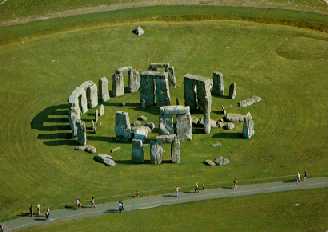

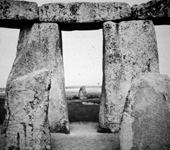

Upon 20th century archaeological inquiry, it was discovered that the Stonehenge just described was one of several versions constructed on the site. The first (Stonehenge I) was built in 2400 B.C., and appears to have been by far the most practical. The Stonehenge we see today is Stonehenge III, and seems to be more of a monument to the earlier Stonehenges , a massive commemoration (perhaps ceremonial) of the earlier site, perhaps like the erection of a cathedral rather than a small, more practical church. One thing is for sure: with its smaller ring diameter, Stonehenge III is less accurate than its predecessors.
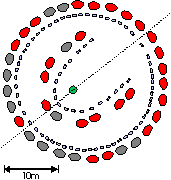
Let us design a few Stonehenge-like plans for different places on Earth. For this we will use two methods: (1) seat-of-the pants using our solar motion demonstrators, and (2) using a calculator. Using a protractor, we will sketch lines of sight for midsummer (summer solstice) sunrise and sunset and midwinter (winter solstice) sunrise and sunset.
First, review the behavior of the sun during the year by filling in the following table.
| Date | Name | Right Ascension (hours) | Declination (degrees north or south) |
| March 21 | Spring Equinox | ||
| Summer Solstice | |||
| Autumn Equinox | |||
| Dec. 21 |
We will use the earthbound coordinate system of altitude and azimuth. Altitude measure the angle of an object in degrees above the horizon. So an object on the horizon has an altitude of 0 degrees, and an object straight overhead at the zenith has an altitude of 90 degrees. Azimuth is usually measured starting at North and increasing toward the East, so that an object due East has azimuth 90 degreees, and object due south has an azimuth of 180 degrees, and an object due west has an azimuth of 270 degrees.
Write some azimuths around the green portion of your solar motion demonstrator. Fill in the following table using your solar motion demonstrator tool. Each tick represents 10 degrees. Try to estimate the azimuths to the nearest degree. The Keck telescope is located on the big island of Hawaii.
| Location | Latitude | Az. of summer sol. sunrise | Az. of winter sol. sunrise | Az. of summer sol. sunset | Az. of winter sol. sunset |
| Equator | 0.0 | ||||
| Pullman |
46.8 | ||||
| Stonehenge | 51.2 | ||||
| Anchorage |
60.5 |
Next, upack your calculator and try the following formula.
Where
| Location | Latitude | D (from formula) | Az. of summer sol. sunrise (90-D) | Az. of winter sol. sunrise (90+D) | Az. of summer sol. sunset (270+D) | Az. of winter sol. sunset (270-D) |
| Equator | 0.0 | |||||
| Pullman |
46.8 |
|||||
| Stonehenge | 51.2 | |||||
| Anchorage |
60.5 |
The formula assumes a perfectly flat horizon. Q1: How do the numbers in the second table compare with the numbers in the first? (Approximately, by how many degrees do the two estimates differ, on average?)
Next, using a ruler and protractor, sketch in lines of sight for the following observatory plans for each of 4 phenomena listed in the above tables. The first one, for the equator, is done for you, as a model.
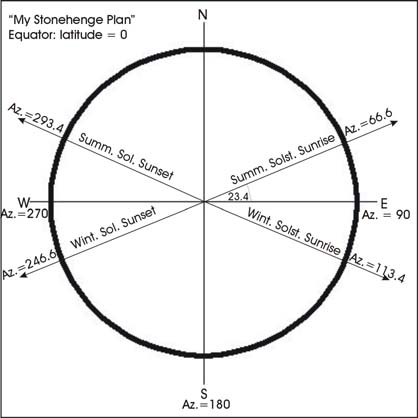



Finally, note that, as in the figure below, if you look north, at the
celestial north pole (CNP), the altitude of the CNP above the horizon
is the same as the observer's latitude. (This checks for the equator, where
the CNP is right on the horizon, and for the north pole, where the CNP
is exactly overhead). Furthermore, the angle between the CNP and the celestial
equator must always be 90 degrees. So if the sun is on the celestial equator
then its noontime altitude can be found by adding all the angles: (Latitude)
+ (90) + (Sun Alt.) = (180).
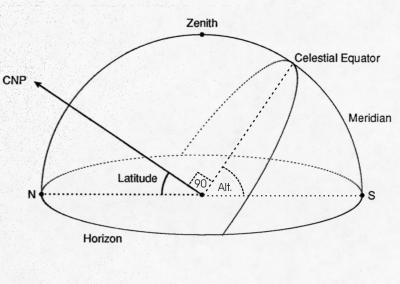
| Location | Latitude | Alt. of spring equinox noon sun | Alt. of summer solstice noon sun | Alt. of fall equinox noon sun | Alt. of winter solstice noon sun |
| Equator | 0.0 | ||||
| Pullman | 46.8 | ||||
| Stonehenge | 51.2 | ||||
| Anchorage | 60.5 |
The builders of Stonehenge originally found that the sun reached the same spot on the horizon at midsummer by patient observation over several years. It must have been quite a discovery for these stone-age tribesmen! In your writeup, tell how you could (Q2) find north, (Q3 ) find your present latitude, and (Q4) set up a (small) stonehenge that would point to the rising and setting suns at the equinoxes and solstices. You can use measurement devices like a protractor, string, astrolabe (a protractor with a plumb-bob attached), and your solar-motion demonstrator, but you have to be able to do the job in a few days or nights - you can't wait years to see where the Sun actually goes.
